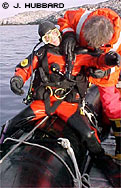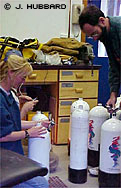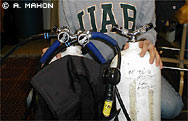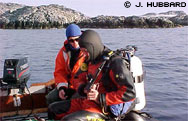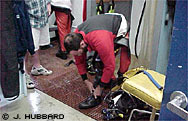 |
|
 |
Chuck's Journal: Dive Ops The Tools
March 27, 2000
Chuck Amsler
Preparation for a day's diving operations (dive ops) at Palmer Station really begins the evening before. Someone, usually but not always me, refills all the scuba tanks from a bank of four large compressed air cylinders called a cascade system and, later, fires up the air compressor to refill the cascade system for the next night. Our primary scuba tanks hold 95 cubic feet of air. We have six of those. We also have a number of smaller tanks that hold 72 cubic feet and are fine if needed for shorter and shallower second dives. Each tank is equipped with a "slingshot" valve. These special Y-shaped valves have two separate openings. That allows us to dive with two completely independent regulators on our tanks. The regulators are what we breathe from. They reduce the air pressure from that of the tank and deliver whatever specific pressure we need to be able to breathe at any water depth. One problem in polar diving is having a regulator freeze -- usually open -- during a dive. Freeze-up is much more of a potential problem in the colder water at McMurdo Station, which is about 13 degrees of latitude further south, and even there -- because of a combination of very special care and state of the art equipment -- problems with the regulators we are using are quite rare. Nevertheless it is a concern, and so having two completely independent regulators on the tank is an important safety feature.
Perhaps second only to our regulators in making "modern" polar diving safe and relatively comfortable are the variable-volume dry suits. As I noted above, we are able to add air to our suits as we descend and remove air as we come back up, which safely maintains the layer of insulating air around our bodies. The first scientist to dive in Antarctica was Mike Neushul in 1958. He was a graduate student at UCLA at the time and went onto a distinguished career in marine botany. Neushul and his U.S. Navy UDT buddy had early model dry suits available to them but found that heavy wet suits kept them warmer. That was true of the other Antarctic diver pioneers who followed until the invention of the modern, variable-volume suits we have now.
Coming off the first stage of one of the regulators is a pressure gauge that allows us to know how much air is still in the tank while we are diving. There are also two inflator hoses coming off the regulators. One runs to our dry suit and one to our buoyancy compensator (BC). The pressure gauge and BC are just like those that divers use everywhere. However, we use the BCs differently. Actually we hardly use them at all here and don't even wear them when we are diving through holes in the ice at McMurdo.
As the air in our dry suits compresses while we descend, we become less buoyant. To compensate, we add air to our dry suits. Since the air beneath the suit has been warmed by our bodies and is what is keeping us warm, and because a compressed dry suit could actually pinch one's skin if it got very tight, we want to make sure we have air in the suit. The wetsuits that people wear in warmer water also compress as one goes deeper, although not as much as a dry suit, and so there folks compensate by adding air to their BCs instead. We only add air to our BCs if we have a long swim back to the boat after surfacing. They are like life jackets and so primarily float the upper body; that makes it easier for us to keep our legs in the water to kick than if we added extra air to the whole dry suit. They float our tanks while we get back into the boat, as described in the upcoming third part to this Dive Ops series.
Another very important piece of equipment that is attached to our regulators is each person's dive computer. The kind we use need not be part of the regulator assembly, but it is very convenient to have them mounted right next to the submersible pressure gauge so we can see both instruments at the same time. The computers monitor and display our depth and time underwater. They then compute how long we can safely stay at depth and still be safely within the no-decompression diving limits. These computers are commonly used by divers everywhere these days. Though not specific to polar diving, they are a particularly useful safety tool here too.
Beneath the suits we wear thick polypropylene underwear and then a very thick insulating "underwear" jumpsuit. These hold onto the trapped, insulating air. And it is a lot of air, all told, so we need to wear a lot of weight to compensate. I personally wear a bit over 40 pounds of lead with my dry suit to allow me to get and stay underwater. Six pounds of that can be in circular weights that clip around your ankles to help keep your feet and legs down, but most is worn in a belt/harness around the torso. The weights are on the belt part at the waist, and the harness straps help distribute the weight to the shoulders. The weights are "soft" lead shot pouches that fit into pockets on the belt. There are quick release cords holding the pockets onto the belt so that the weights can be dropped immediately if necessary in an emergency.
Our dry suits have built-in boots and water tight seals at the wrists and neck. They have hard rings built in at the top of the wrist seals. We wear heavy rubber dry gloves over thick wool or fleece liners. Three finger mittens keep us warmer than five finger gloves, but the five finger gloves are easier to work in. We use both, but here at Palmer mostly the five finger gloves
The gloves and mittens stay dry because they can be stretched over the hard wrist rings to make a water tight seal. We put short pieces of narrow-diameter plastic tubing under the wrist seals to make an air connection between the glove and rest of the suit. Because of this, when we put our hands down below our bodies to collect something, the slightly greater water pressure forces air out of the gloves and into the sleeves so we have more finger dexterity. Alternately, when our fingers get cold we can put them above us in the water. Then the slightly greater water pressure in the rest of our suits forces air that has been warmed by our bodies up into the gloves.
If you were to see us during a safety stop at the end of one of our dives you'd think we were being mugged because we commonly have both hands raised up above our heads to let that warmer air up around our cold fingers. If one of our gloves gets a significant leak, the sudden inflow of icy water feels something like being hit in the hand by a hammer over and over again. So, should that happen we would not stay in the water long enough for much water to leak up into the arm of the suit through the narrow plastic tubes under the seal.
Our dry suits also have a seal at the neck as well as a thin rubber hood that covers the head. This hood lets water in around our heads and we wear various types of wet insulation with it. Some of us use wet suit hoods and some use a kind of foamy pad-like bonnet under the rubber hood. I personally have been using the bonnet under the thin hood and, on many of my dives, also a light weight wet suit hood over both.
The wet suit hood is actually more to keep air from getting trapped between the pad and thin hood than for warmth, although it does add insulation. The trapped air is what I call "the conehead problem" and is something I would otherwise have with the "backup" dive mask I have been using recently. That mask allows a little bit of air to seep up from the mask and under the thin rubber hood. I'm looking forward to a replacement part to come for my primary, non-conehead-forming mask on the next ship. Kudos to the good folks at the dive shop in Birmingham for taking one of their stock masks apart so that a "spare" part would be available quick enough to get it onto the next ship.
The thin rubber hood seals down over the top of our masks so there is usually no exposed skin above the mask. The only part of our bodies that is exposed directly to the water is the area right around our mouths. That gets numb very, very quickly after we enter the water, and so the cold there is not noticeable for long. As long as the water we are in is warm enough to be liquid, which of course it always is even though the top may be frozen over, the liquid inside our skin cells does not freeze either. Because of that, frostbite is not a concern for the lengths of time we stay in the water.
And how long do we stay in the water? Usually between 20 and 40 minutes, depending on how deep we are diving and what we need to do. The longest I can recall being in the water here is about an hour. The thing that gets cold first and fastest is our hands. Even though the dry gloves and mittens are great and the tubes to pipe in warmer air help, we just cannot wear as much insulation under them as we do elsewhere and still be able to use our fingers for anything.
What we are doing with those fingers, etc., to get us into and out of the water and while working there will be the focus of an upcoming journal entry. |
 |
|
|
|

